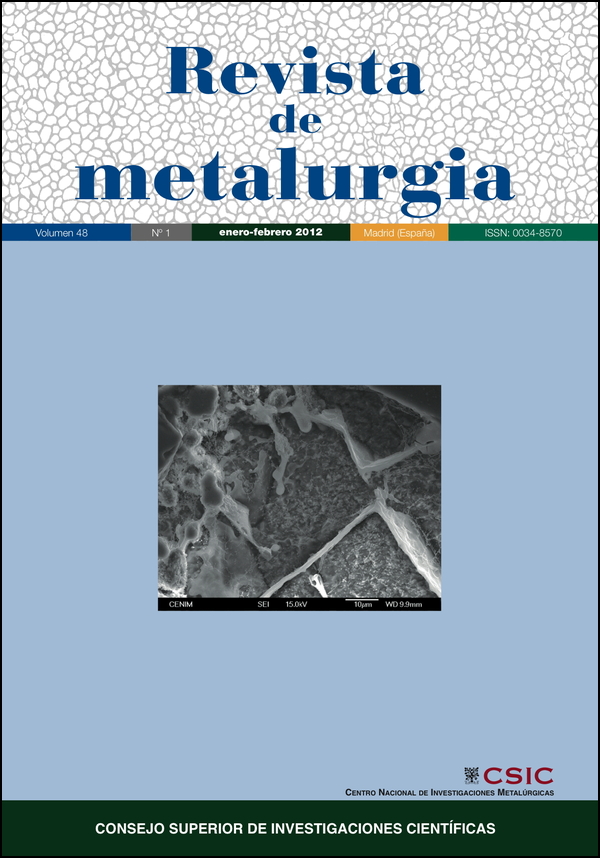A microencapsulation process of liquid mercury by sulfur polymer stabilization/solidification technology. Part II: Durability of materials
DOI:
https://doi.org/10.3989/revmetalm.1137Keywords:
Mercury, Sulfur polymer stabilization/solidification (SPSS), Durability, Water absorption, Salt aging, Freeze-thawAbstract
Under the European LIFE Program a microencapsulation process was developed for liquid mercury using Sulfur Polymer Stabilization/Solidification (SPSS) technology, obtaining a stable concrete-like sulfur matrix that allows the immobilization of mercury for long-term storage. The process description and characterization of the materials obtained were detailed in Part I. The present document, Part II, reports the results of different tests carried out to determine the durability of Hg-S concrete samples with very high mercury content (up to 30 % w/w). Different UNE and RILEM standard test methods were applied, such as capillary water absorption, low pressure water permeability, alkali/acid resistance, salt mist aging, freeze-thaw resistance and fire performance. The samples exhibited no capillarity and their resistance in both alkaline and acid media was very high. They also showed good resistance to very aggressive environments such as spray salt mist, freeze-thaw and dry-wet. The fire hazard of samples at low heat output was negligible.
Downloads
References
[1] UNEP, Draft technical guidelines on the environmentally sound management of mercury wastes, 4th Draft, april, 2009. http://www.basel.int/techmatters/mercury/guidelines/040409.doc
[2] Directive 2000/60/EC of the European Parliament and of the Council of 23 October 2000, Establishing a framework for Community action in the field of water policy. Official Journal L 327, 22/12/2000; 0001-0073.
[3] Regulation (EC) No 1102/2008 of the European Parliament and of the Council of 22 October 2008 on the banning of exports of metallic mercury and certain mercury compounds and mixtures and the safe storage of metallic mercury, Official Journal of the European Union. L 304 (14/11/2008), pp. 75-79.
[4] European Commission, Brussels, Requirements for facilities and acceptance criteria for the disposal of metallic mercury. Bipro. Final Report. 16, april, 2010.
[5] R. Malviya and R. Chaudhary, J. Hazard. Mater. B137 (2006) 267-276. http://dx.doi.org/10.1016/j.jhazmat.2006.01.065 PMid:16530943
[6] J.M. Zhuang, T. Lo, T. Walsh and T. Lam. J. Hazard. Mater. B113 (2004) 157-164. http://dx.doi.org/10.1016/j.jhazmat.2004.06.003 PMid:15363526
[7] X.Y. Zhang, Q.C. Wang, S.Q. Zhang, X.J. Sun and Z.S. Shang, J. Hazard. Mater. 168 (2009) 1575-1589. http://dx.doi.org/10.1016/j.jhazmat.2009.03.050 PMid:19376646
[8] P. Randall P and S. Chattopadhyay, J. Hazard. Mater. B114 (2004) 211-223.
[9] M. Fuhrmann, D. Relamed, P.D. Kalb, J.W. Adams and L.W. Milina, Waste Manage. 22 (2002) 327-333. http://dx.doi.org/10.1016/S0956-053X(01)00057-5
[10] F.A. López, A. López-Delgado, F.J. Alguacil and M. Alonso, Spanish Patent P200930672, 2009.
[11] F. Sandrolini, S. Manzim and A. Andrucci, Compos. Part A-Appl. S. 37 (2006) 695-702.
[12] A. López-Delgado, F.A. López, F.J. Alguacil, I. Padilla and A. Guerrero, Rev. Metal. Madrid 48 (2011) 45-57.
[13] UNE-EN 480-5: 2006 Admixtures for concrete, mortar and grout. Test methods. Part 5: Determination of capillary absorption. AENOR.
[14] RILEM, Water absorption under low pressure. Pipe method. Test No. II.4, tentative recommendations. Paris, 1980.
[15] UNE-EN 13580:2003 Products and systems for the protection and repair of concrete structures. Test methods. Water absorption and resistance to alkali for hydrophobic impregnations.
[16] UNE-EN 14147:2003 Natural stone test methods, Determination of resistance to aging by salt mist.
[17] ISO 20394:2007 Thermal-insulating materials. Determination of freeze-thaw resistance.
[18] EN ISO 11925-2:2002 Reaction to fire tests. Ignitability of building products subjected to direct impingement of flame - Part 2: singleflame source test.
[19] F.J. Alejandre, Historia, caracterización y restauración de morteros. Ed. Univ. Sevilla. Insto. Universitario de Ciencias de la Construcción. Sevilla, España, 2002, pp. 67-70.
Downloads
Published
How to Cite
Issue
Section
License
Copyright (c) 2012 Consejo Superior de Investigaciones Científicas (CSIC)

This work is licensed under a Creative Commons Attribution 4.0 International License.
© CSIC. Manuscripts published in both the printed and online versions of this Journal are the property of Consejo Superior de Investigaciones Científicas, and quoting this source is a requirement for any partial or full reproduction.
All contents of this electronic edition, except where otherwise noted, are distributed under a “Creative Commons Attribution 4.0 International” (CC BY 4.0) License. You may read the basic information and the legal text of the license. The indication of the CC BY 4.0 License must be expressly stated in this way when necessary.
Self-archiving in repositories, personal webpages or similar, of any version other than the published by the Editor, is not allowed.
















